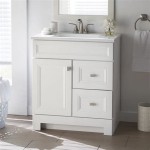Tiny Bathroom Sink Solutions: Maximizing Space and Style
The bathroom, often the smallest room in a home, presents unique spatial challenges. In compact bathrooms, every square inch counts, and selecting the right fixtures becomes paramount. The sink, a functional necessity, can significantly impact the overall layout and usability of a tiny bathroom. Thus, the selection of a "tiny bathroom sink" requires careful consideration of size, style, and functionality.
This article explores the various options available for tiny bathroom sinks, focusing on design principles, material choices, installation considerations, and storage solutions. It strives to provide a comprehensive overview to guide homeowners and designers in making informed decisions for optimizing space and aesthetics in small bathrooms.
Understanding Spatial Constraints and Measurement
Before exploring specific sink types, a thorough assessment of the available space is crucial. This involves accurately measuring the area designated for the sink, including the width, depth, and height. Consider the placement of existing plumbing lines, as relocating them can add significant cost and complexity to the project. The swing of the bathroom door, the proximity to the toilet and shower, and any existing obstructions must also be taken into account.
The standard depth of a bathroom sink is typically between 19 and 23 inches. However, for tiny bathrooms, sinks with depths as shallow as 12 inches are available and can make a significant difference in maneuvering space. Width is another critical factor. While standard sinks can be 20-30 inches wide, tiny bathroom sinks often range from 14 to 18 inches. Height is generally standardized around 31-36 inches, but wall-mounted sinks offer flexibility in adjusting the height to suit individual needs and preferences.
Accurately documenting these measurements will prevent the selection of a sink that is too large or unsuitable for the bathroom's layout. It's also recommended to create a scale drawing or utilize bathroom design software to visualize how different sink sizes and styles will fit within the space. This allows for experimentation with different layouts and helps to avoid costly mistakes.
Exploring Different Types of Tiny Bathroom Sinks
Several types of sinks are particularly well-suited for small bathrooms, each offering distinct advantages and disadvantages in terms of space efficiency, aesthetics, and installation. These include wall-mounted sinks, corner sinks, pedestal sinks, and vanity sinks.
Wall-Mounted Sinks: These sinks are directly attached to the wall, freeing up floor space underneath. This creates an illusion of greater openness and makes cleaning easier. Wall-mounted sinks are available in various shapes and materials, from sleek, modern designs to more traditional styles. The absence of a vanity or pedestal can, however, limit storage options. Plumbing is typically exposed, requiring careful attention to the aesthetic appeal of the drainpipe and supply lines. Concealing these lines within the wall during renovations can create a cleaner look.
Corner Sinks: These sinks are designed to fit into the corner of a room, maximizing the use of otherwise underutilized space. Corner sinks are particularly effective in extremely small bathrooms where every inch is precious. They are available in a variety of materials and styles, but the triangular or angled shape is consistent. Similar to wall-mounted sinks, corner sinks often lack integrated storage, requiring alternative solutions for toiletries and other bathroom essentials.
Pedestal Sinks: These sinks consist of a basin supported by a freestanding pedestal. Pedestal sinks offer a classic and elegant look, but they provide minimal or no storage space. They are generally less space-efficient than wall-mounted or corner sinks, as the pedestal occupies floor space. However, they can be a good option in bathrooms where aesthetics are prioritized over storage. The plumbing is partially concealed within the pedestal, providing a cleaner appearance than directly exposed pipes.
Vanity Sinks: These sinks are integrated into a cabinet or vanity unit, providing both a sink and enclosed storage space. While vanity sinks can be larger than other types, compact vanity models are specifically designed for small bathrooms. These smaller vanities typically feature shallower depths and narrower widths. Wall-mounted vanities, which float above the floor, further enhance the sense of spaciousness. Adequate storage within the vanity is crucial for keeping toiletries and cleaning supplies organized and out of sight. The choice of vanity style should complement the overall bathroom decor.
Material Considerations for Tiny Bathroom Sinks
The material of a tiny bathroom sink not only affects its appearance but also its durability, maintenance requirements, and cost. Common materials include vitreous china, porcelain, glass, stainless steel, and stone.
Vitreous China: This is a popular choice for bathroom sinks due to its durability, stain resistance, and relatively low cost. Vitreous china is a type of ceramic that has been fired at high temperatures to create a smooth, non-porous surface. It is easy to clean and maintain, requiring only regular wiping with a mild cleaner. Vitreous china sinks are available in a wide range of styles and colors, making them a versatile option for any bathroom design.
Porcelain: Similar to vitreous china, porcelain is another durable and stain-resistant ceramic material. Porcelain sinks are often slightly more expensive than vitreous china sinks, but they offer a similar level of performance and aesthetics. Both vitreous china and porcelain are relatively heavy materials, which can be a consideration for wall-mounted installations requiring adequate structural support.
Glass: Glass sinks offer a unique and contemporary look. They can be made from clear, frosted, or colored glass, and they are often shaped in distinctive designs. Glass sinks require careful cleaning to avoid water spots and streaks. While glass is generally durable, it is more susceptible to chipping or cracking than vitreous china or porcelain. Tempered glass is a stronger option that is less likely to shatter.
Stainless Steel: Stainless steel sinks are known for their durability and modern appearance. They are resistant to rust and corrosion, making them a good option for high-moisture environments. Stainless steel sinks are also relatively lightweight, which can be advantageous for wall-mounted installations. However, they can be prone to scratching and water spots, requiring regular cleaning to maintain their appearance. The industrial aesthetic of stainless steel may not suit all bathroom designs.
Stone: Stone sinks, such as granite, marble, or travertine, offer a luxurious and natural aesthetic. They are highly durable and can add a touch of elegance to any bathroom. However, stone sinks are typically more expensive than other options, and they require special care and maintenance. Some types of stone are porous and may require sealing to prevent staining. The weight of stone sinks can also be a consideration for installation.
Optimizing Storage in a Tiny Bathroom Sink Area
Storage is a critical consideration in a small bathroom, and the sink area presents an opportunity to maximize available space. While some tiny bathroom sinks, such as wall-mounted or pedestal sinks, offer minimal or no integrated storage, there are several ways to address this challenge.
Floating Shelves: Installing floating shelves above or to the side of the sink provides a convenient and stylish way to store toiletries, hand towels, and decorative items. Floating shelves create an open and airy feel, enhancing the sense of spaciousness in a small bathroom. The height and depth of the shelves should be carefully considered to avoid obstructing movement or feeling cluttered.
Mirrored Cabinets: Replacing a standard bathroom mirror with a mirrored cabinet offers hidden storage space without sacrificing the functionality of a mirror. These cabinets are available in various sizes and styles, and they can be recessed into the wall for a flush appearance. Mirrored cabinets are ideal for storing small items such as medications, toothbrushes, and skincare products.
Under-Sink Storage: If a vanity sink is not chosen, consider adding a small cabinet or shelving unit beneath a wall-mounted or corner sink. This provides valuable storage space for cleaning supplies, extra towels, or other bathroom essentials. Ensure that the under-sink storage unit is appropriately sized and styled to complement the sink and the overall bathroom decor.
Over-the-Toilet Storage: While not directly related to the sink area, over-the-toilet storage units can provide additional storage space in a small bathroom. These units typically feature shelves or cabinets above the toilet, allowing for the storage of toiletries, towels, or decorative items. Choose a unit that is appropriately sized and styled to fit comfortably within the bathroom.
Vertical Storage Solutions: Utilizing vertical space is key in a small bathroom. Consider adding tall, narrow cabinets or shelving units to maximize storage without occupying too much floor space. These vertical storage solutions can be used to store a variety of items, from towels and toiletries to cleaning supplies and decorative objects.
Careful planning and selection of appropriate storage solutions can significantly enhance the functionality and organization of a tiny bathroom, creating a more comfortable and enjoyable space.
Installation Considerations for Tiny Bathroom Sinks
Proper installation is crucial for the functionality and longevity of any bathroom sink. Whether installing a wall-mounted, corner, pedestal, or vanity sink, it's essential to follow manufacturer's instructions and local plumbing codes. In some cases, professional installation may be necessary, particularly for complex plumbing modifications.
Wall-Mounted Sink Installation: Installing a wall-mounted sink requires ensuring that the wall has adequate structural support to bear the weight of the sink and any associated loads. This may involve reinforcing the wall studs or using specialized mounting hardware. Accurate leveling is critical to prevent water from pooling on the sink surface. Plumbing connections must be properly sealed to prevent leaks.
Corner Sink Installation: Installing a corner sink requires careful alignment with the corner of the room. Accurate measurements are essential to ensure a proper fit. Plumbing connections must be adapted to the corner configuration. As with wall-mounted sinks, adequate wall support is crucial.
Pedestal Sink Installation: Installing a pedestal sink involves securing the basin to the wall and then attaching the pedestal to the floor. Accurate alignment of the basin and pedestal is essential for stability. Plumbing connections must be made within the pedestal, ensuring proper sealing to prevent leaks. While generally less demanding than wall-mounted installations, proper leveling is still essential.
Vanity Sink Installation: Installing a vanity sink involves connecting the sink to the vanity unit and then securing the unit to the wall or floor. Accurate leveling of the vanity unit is crucial for proper drainage. Plumbing connections must be made within the vanity cabinet, ensuring proper sealing to prevent leaks. Electrical considerations may be necessary for vanities with integrated lighting or outlets.
Prior to any installation, turn off the water supply to the bathroom. Carefully inspect all plumbing connections for leaks after the installation is complete. Consult with a qualified plumber if you are unsure about any aspect of the installation process.

Vanities For Small Bathrooms

Sinks For Small Bathrooms Guide Lowe S

15 Small Bathroom Vanity Ideas That Rock Style And Storage

14 Splendid Small Bathroom Sink Ideas Shelfgenie

8 Small Bathroom Sinks That Will Make A Big Impact Architectural Digest

14 Genius Small Bathroom Design Ideas

Small Bathroom Makeover Ideas Hallstrom Home

Small Bathroom Vanities

Bathroom Sink Ideas For Small Spaces Hunker

10 Small Powder Room Vanity Ideas You And Your Guests Will Both Love
Related Posts







